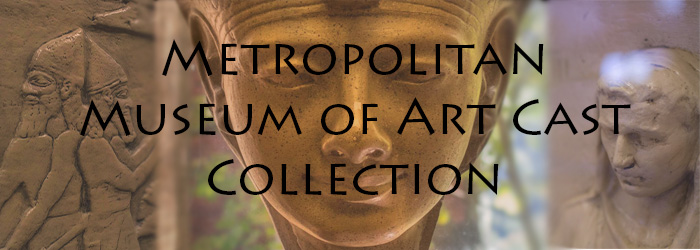
Description
Plaster cast of Nike Sacrificing a Bull. Original was found in the Villa of Antoninus Pius at Lanavium (southeast Rome), now housed in the British Museum, circa 2nd century CE.
Publication Date
1978
Type of Artwork
Statue
Time Period/Geographical Region
Ancient Greece
Height (cm/in)
72.39 cm / 28.5 in
Width (cm/in)
88.9 cm / 35 in
Depth (cm/in)
29.21 cm / 11.5 in
Disciplines
Ancient History, Greek and Roman through Late Antiquity | Sculpture
Recommended Citation
Morehead State University. Camden-Carroll Library., "Nike Sacrificing a Bull" (1978). Metropolitan Museum of Art Cast Collection. 28.
https://scholarworks.moreheadstate.edu/metropolitan_art_collection/28
Files
Download
Download Image (188 KB)


Comments
Nike is the Greek goddess of Victory, adopted by the Romans as Victoria. In this sculpture grouping she is sacrificing a bull with a knife, pulling the beast's head back to cut its throat. When the cast arrived at MSU, the knife was damaged. The present state of the cast was reworked during the conservation process. Images of gods and goddesses would be found in public forums, in temples, and also in private residences of wealthy Romans. This sculpture grouping was found in the villa of emperor Antoninus Pius, whose bust you can see in the MSU cast collection.
A round stamp on the base of the cast reads, "D. Brucciani, Galleria delle Belle Arti, 40 Russell St. London." Domenico Brucciani (c. 1815–1880) was an Italian-born plaster molder who described himself as "Formatore [i.e. Maker] and Modeler to the Science and Art Department" of the Natural History Museum of London, as well as to the British Museum and the Royal Academy of Arts. When Brucciani died at 65 in 1880, his business and stock-in-trade were advertised for sale; in 1891, Joseph L. Caproni was trading as D. Brucciani & Co. By World War I, the plaster cast business was in decline. In response to the threat of their unique collection of plaster molds and casts being dispersed, a shipowner, Sir William Petersen, supplied the means for the business to carry on through the war, but it was liquidated in 1921. The company was taken over by the Board of Education and run by the Victoria and Albert Museum as a service, renamed the Department for the Sale of Casts, until financial losses forced its closure in 1951.